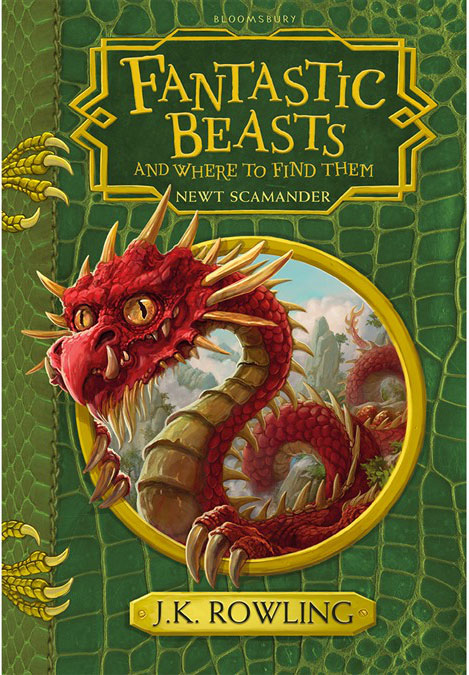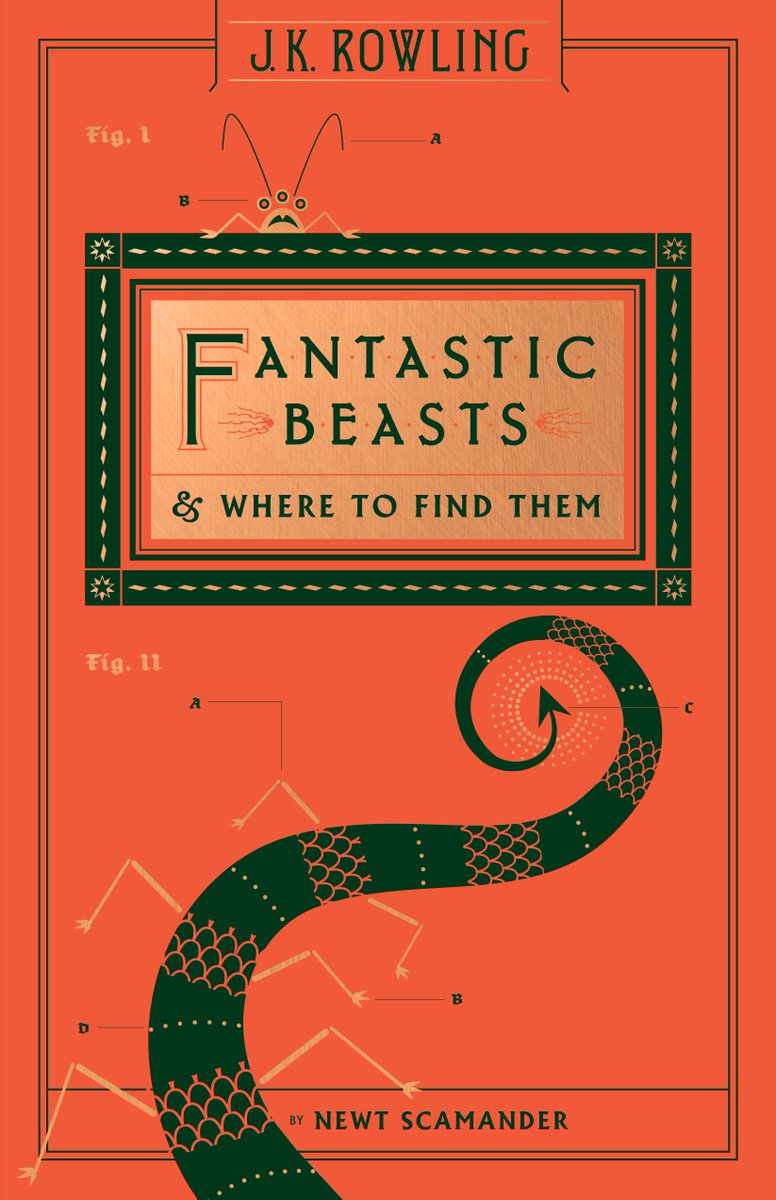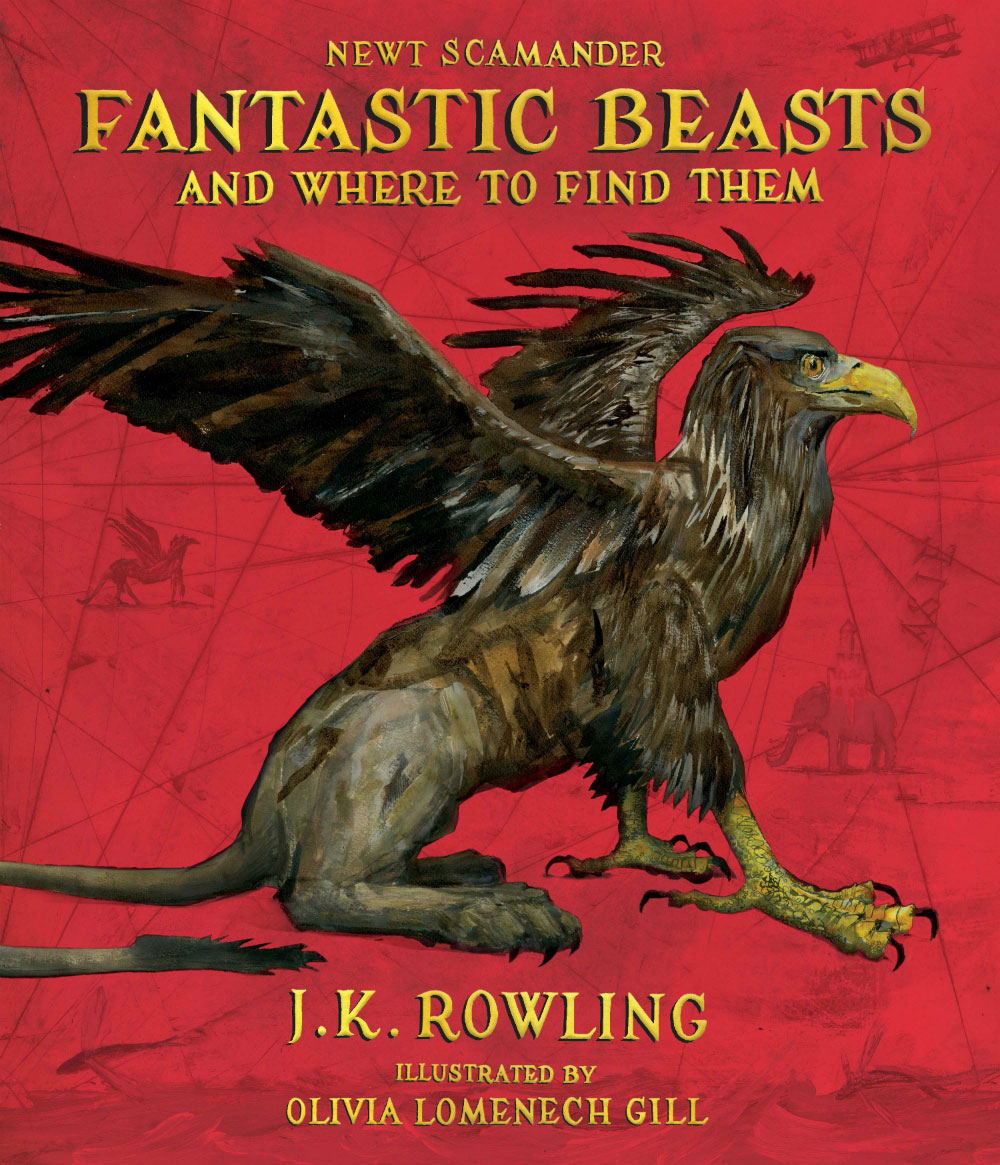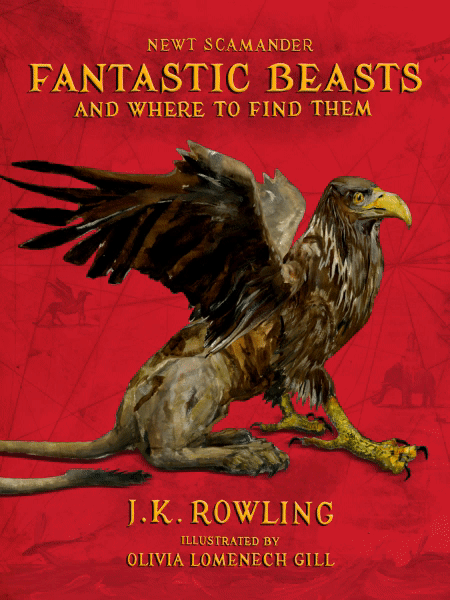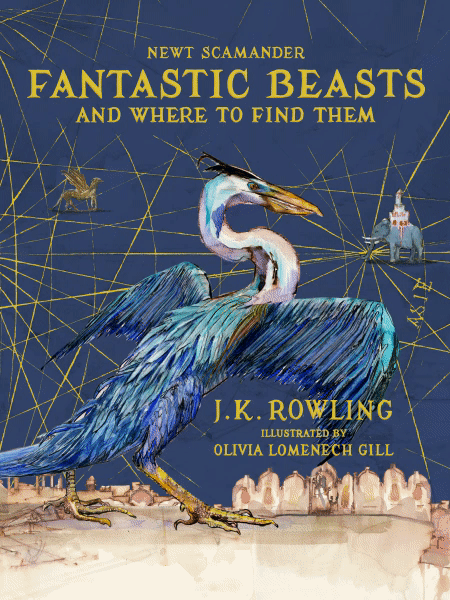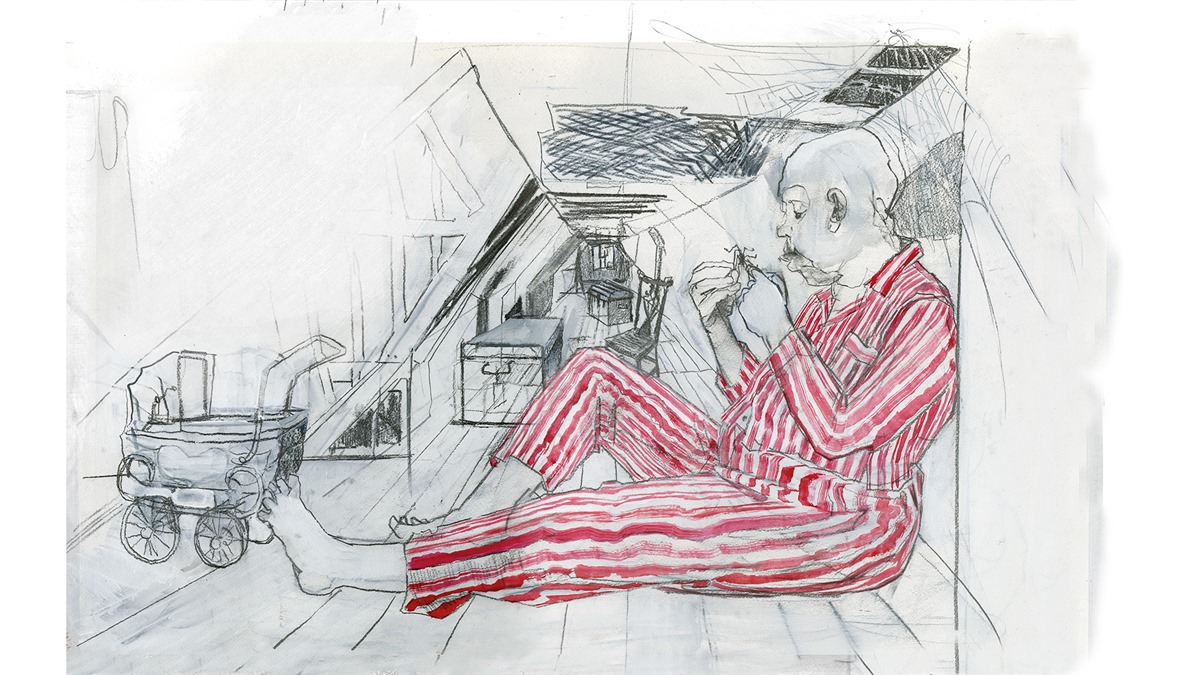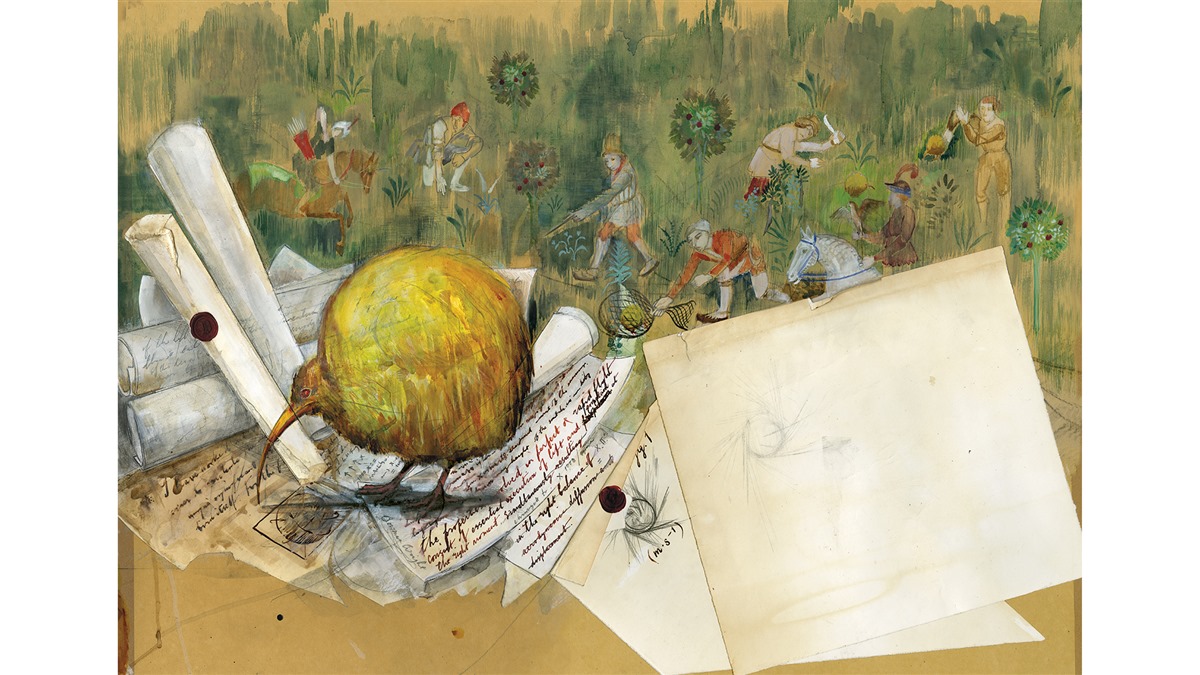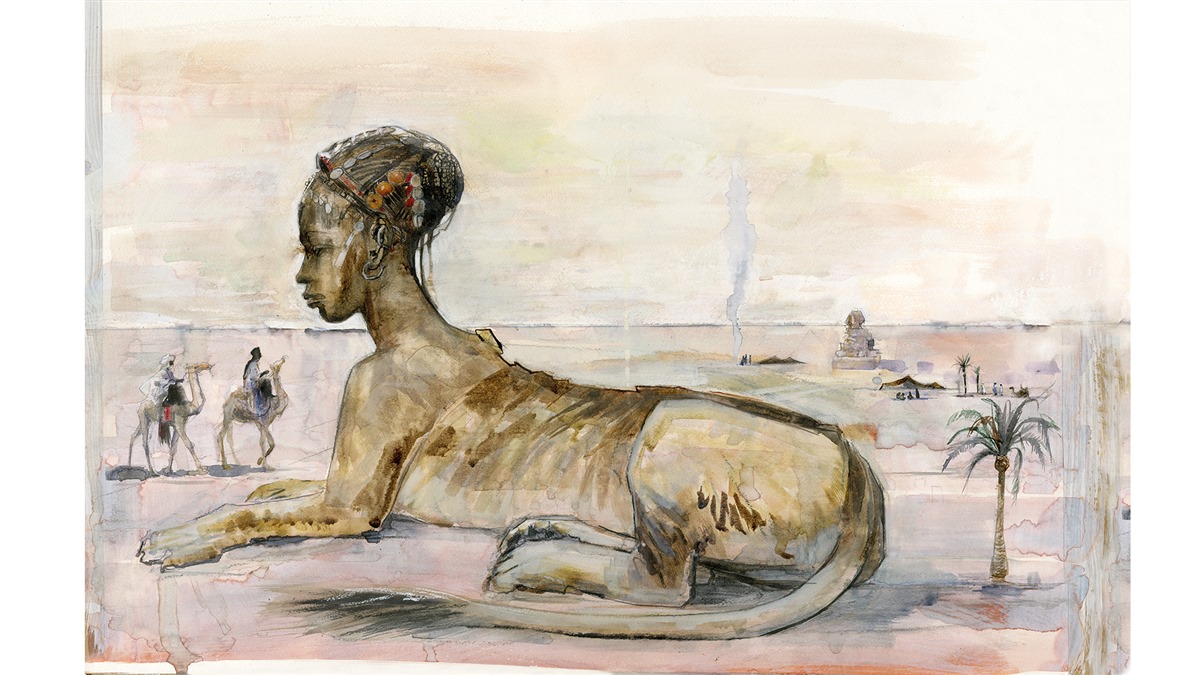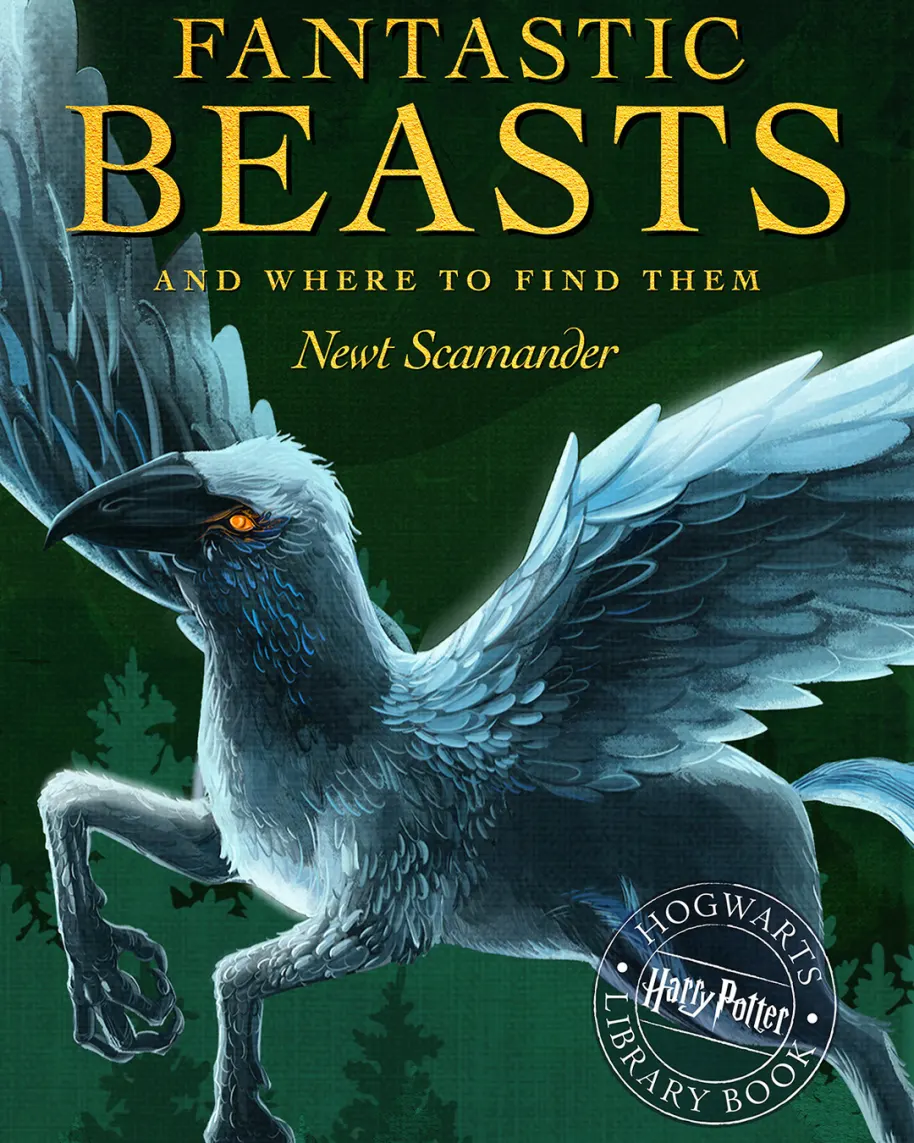Released in March 2001, Fantastic Beasts and Where to Find Them is an encyclopedia of magical beasts. It contains the history of Magizoology and describes a plethora of magical species found around the world, as well as the beasts’ Ministry of Magic classifications.
Author Newt Scamander collected most of the information found in the book through observations made over years of travel across five continents. He notes that the first edition was commissioned in 1918 by Mr. Augustus Worme of Obscurus Books but was not published until 1927. In the wizarding world, the book is a required textbook for first-year Hogwarts students.
Early editions of the book feature fictional doodles and comments in it by Harry, Ron, and Hermione that appear to have been written around the time of the fourth book. Integrated into the design, the cover of the first edition appears to have been clawed by some sort of animal.
A copy of Fantastic Beasts & Where to Find Them resides in almost every wizarding household in the country. Now, for a limited period only, Muggles too have the chance to discover where the Quintaped lives, what the Puffskein eats, and why it is best not to leave milk out for a Knarl.
– Back cover description
Fantastic Beasts and Where to Find Them was first published in 2001 and featured 75 magical species. With Newt Scamander credited as its author, this original edition, which opens with a foreword written by Albus Dumbledore, is a replica of the book Harry Potter purchased just before his first year at Hogwarts and thus includes handwritten annotations by Harry, Ron, and Hermione.
Following the release of the film Fantastic Beasts and Where to Find Them, a new edition of the book was published in March 2017. An e-book version, whose cover was redesigned by Olly Moss, and an audiobook, which is narrated by Eddie Redmayne and features some sound effects, of this 2017 edition were also published simultaneously. There is also a new foreword written by Newt Scamander, replacing Albus Dumbledore's.
In the new foreword, Newt states that at the request of MACUSA President Seraphina Picquery, earlier editions of Fantastic Beasts did not include American beasts because "she wished to deter wizarding sightseers" but that these beasts have been reinstated in this edition, which added six new creatures: the hidebehind, the hodag, the horned serpent, the snallygaster, the thunderbird, and the wampus. J.K. Rowling’s name appears on the cover, and Harry's, Ron's, and Hermione’s remarks were removed.
19% of the suggested retail price of every copy of Fantastic Beasts and Where to Find Them sold goes directly to Comic Relief, which uses it to help poor children and young people in various places around the world. According to Comic Relief, sales from this book and its companion, Quidditch Through the Ages, have raised nearly £20 million since 2001.
A series of five films based on the textbook is currently being made. The first film made its debut in November 2016. Its sequel, Fantastic Beasts: The Crimes of Grindelwald, was released in November 2018. The third and most recent installment, Fantastic Beasts: The Secrets of Dumbledore, was released in April 2022.
Each creature is assigned a classification by the Department for the Regulation and Control of Magical Creatures at the Ministry of Magic in order to give witches and wizards an idea of the creature's level of dangerousness. The classification system includes five categories as follows:
| Ministry of Magic (M.O.M.) Classification | Meaning |
| XXXXX | Known wizard killer / impossible to train or domesticate |
| XXXX | Dangerous / requires specialist knowledge / skilled wizard may handle |
| XXX | Competent wizard should cope |
| XX | Harmless / may be domesticated |
| X | Boring |
The encyclopedia includes the following, along with their Ministry of Magic classification:
| Name | MoM Classification |
| Acromantula | XXXXX |
| Ashwinder | XXX |
| Augurey | XX |
| Basilisk | XXXXX |
| Billywig | XXX |
| Bowtruckle | XX |
| Bundimun | XXX |
| Centaur | XXXX1 |
| Chimaera | XXXXX |
| Chizpurfle | XX |
| Clabbert | XX |
| Crup | XXX |
| Demiguise | XXXX |
| Diricawl | XX |
| Doxy | XXX |
| Dragon2 | XXXXX |
| Dugbog | XXX |
| Erkling | XXXX |
| Erumpent | XXXX |
| Fairy | XX |
| Fire Crab | XXX |
| Flobberworm | X |
| Fwooper | XXX |
| Ghoul | XX |
| Glumbumble | XXX |
| Gnome | XX |
| Graphorn | XXXX |
| Griffin | XXXX |
| Grindylow | XX |
| Hidebehind | XXXX |
| Hippocampus | XXX |
| Hippogriff | XXX |
| Hodag | XXX |
| Horklump | X |
| Horned Serpent | XXXXX |
| Imp | XX |
| Jarvey | XXX |
| Jobberknoll | XX |
| Kappa | XXXX |
| Kelpie | XXXX |
| Knarl | XXX |
| Kneazle | XXX |
| Leprechaun | XXX |
| Lethifold | XXXXX |
| Lobalug | XXX |
| Mackled Malaclaw | XXX |
| Manticore | XXXXX |
| Merpeople | XXXX3 |
| Moke | XXX |
| Mooncalf | XX |
| Murtlap | XXX |
| Niffler | XXX |
| Nogtail | XXX |
| Nundu | XXXXX |
| Occamy | XXXX |
| Phoenix | XXXX4 |
| Pixie | XXX |
| Plimpy | XXX |
| Pogrebin | XXX |
| Porlock | XX |
| Puffskein | XX |
| Quintaped | XXXXX |
| Ramora | XX |
| Red Cap | XXX |
| Re'em | XXXX |
| Runespoor | XXXX |
| Salamander | XXX |
| Sea Serpent | XXX |
| Shrake | XXX |
| Snallygaster | XXXX |
| Snidget | XXXX5 |
| Sphinx | XXXX |
| Streeler | XXX |
| Tebo | XXXX |
| Thunderbird | XXXX |
| Troll | XXXX |
| Unicorn | XXXX6 |
| Wampus Cat | XXXXX |
| Werewolf | XXXXX7 |
| Winged Horse | XX-XXXX |
| Yeti | XXXX |
1 The text notes that the centaur is given a XXXXX classification "not because it is unduly aggressive, but because it should be treated with great respect."
2 There are ten dragon breeds listed: the Antipodean Opaleye, the Chinese Fireball, the Common Welsh Green, the Hebridean Black, the Hungarian Horntail, the Norwegian Ridgeback, the Peruvian Vipertooth, the Romanian Longhorn, the Swedish Short-Snout, and the Ukrainian Ironbelly.
3 Similar to the footnote on centaurs, merpeople get a XXXX rating because they should be treated with great respect.
4 According to the text's footnote, the phoenix gets a XXXXX rating not due to aggression but due to the fact that "very few wizards have ever succeeded in domesticating it."
5 The Golden Snidget gets a XXXX rating because "severe penalties are attached to its capture or injury."
6 Unicorns, like centaurs and merpeople, should also be treated with great respect, thus the reason for their XXXX rating.
7 The text notes that the XXXXX rating for werewolves refers only to their transformed state during the full moon.
Earlier Editions
The following annotations can be found in the earlier editions of Fantastic Beasts:
- On the bookplate page saying "This book belongs to Harry Potter," there is a written conversation between Ron and Hermione below Harry's signature. Below the bookplate with Harry's signed name, Ron writes "shared by Ron Weasley because his fell apart." Hermione then writes "why don't you buy a new one then?" to which Ron replies "write on your own book Hermione." Hermione responds with "you bought all those dungbombs on Saturday, you could have bought a new book instead" to which Ron responds with "Dungbombs rule" (with "rule" underlined).
- On the page opposite the "Contents" page, Ron has written the name of his favorite Quidditch team, the Chudley Cannons, in all capitals. Underneath "CHUDLEY CANNONS," Harry has written, "write a decent team in my book for a change Weasley."
- The section titled "What Is a Beast?" has an arrow drawn pointing from it to the phrase "a big hairy thing with too many legs."
- The section titled "A Brief History of Muggle Awareness of Fantastic Beasts" has the word "brief" circled and the written phrase "you liar" pointing to it.
- Under the section titled "Controls on Selling and Breeding," the text notes that the "1965 Ban on Experimental Breeding has made the creation of new species illegal." The written phrase "but no one's told Hagrid" points to the word "illegal," referring to Hagrid's cross-species breeding of the Blast-Ended Skrewts (a cross between a Fire Crab and a manticore) in Goblet of Fire.
- On the "Ministry of Magic Classifications" page, the most dangerous creatures receive the highest classification of XXXXX, meaning "Known wizard killer / impossible to train or domesticate." The written phrase "or anything Hagrid likes" has been added to the XXXXX category description.
- Under the Acromantula entry on page 3, 9 extra X's have been added to the creature's "XXXXX" Ministry of Magic classification. The extra X's were most likely written in by Ron, who has arachnophobia (a fear of spiders). The Acromantula is a large, carnivorous spider.
- Under the Acromantula entry on page 4, the text notes that "rumors that a colony of Acromantula has been established in Scotland are unconfirmed." The word "unconfirmed" is crossed out and the phrase "confirmed by Harry Potter and Ron Weasley" has been written in, referring to Harry and Ron's encounter with the spider Aragog and his family in the Forbidden Forest in Chamber of Secrets. Hogwarts School of Witchcraft and Wizardry is also confirmed to be located in Scotland.
- Under the basilisk entry on page 8, the text notes that "there have been no recorded sightings of Basilisks in Britain for at least four hundred years." The written comment "that's what you think" has been appended to the bottom of the entry, referring to the fact that a Basilisk was indeed sighted in the Chamber of Secrets by Harry Potter in the second book.
- Under the Billywig entry on page 9, the text notes that their dried stings are believed to be a component in the popular wizarding sweet Fizzing Whizzbees. The phrase "last time I eat them then" is seen scrawled under the entry in response.
- Under the chimaera entry on page 12, the text notes that it is "vicious and bloodthirsty" and that "Chimaera eggs are classified as Grade A Non-Tradeable Goods." The phrase "so Hagrid'll be getting some any time now" has been written in below the entry, referring to Hagrid's propensity for adopting extremely dangerous creatures.
- Under the dragon entry on page 22, the Hungarian Horntail breed is noted to be "supposedly the most dangerous of all dragon breeds," to which the phrase "you're not kidding" is written in and an arrow points to the phrase "most dangerous." Harry had to face off against a Hungarian Horntail in the first task of the Triwizard Tournament in Goblet of Fire.
- Under the dragon entry on page 23, the name of the breed "Norwegian Ridgeback" is crossed out and replaced with "Baby Norbert," referring to the dragon that Hagrid hatched himself from an egg and introduced to the trio in Philosopher's/Sorcerer's Stone.
- Under the Glumbumble entry on page 34, the word "bum" in the creature's name is circled and an arrow points to it.
- Under the hippogriff entry on page 38, the text notes that it "can be tamed, though this should be attempted only by experts." The phrase "though this should be attempted only by experts" is underlined and connected to a note asking, "has Hagrid read this book?" The note refers to Hagrid's domestication of Buckbeak the hippogriff in Prisoner of Azkaban when he took over the Care of Magical Creatures class.
- Under the kappa entry on page 43, the text claims that this creature is Japanese in origin. The word "Japanese" is underlined in the first sentence, which states that "The kappa is a Japanese water demon that inhabits shallow ponds and rivers." A note has been added to the entry, saying, "Snape hasn't read this either." This presumably refers to the third book, in which Snape states, "The kappa is more commonly found in Mongolia."
- Under the leprechaun entry on pages 47–48, the text notes that leprechauns "produce a realistic gold-like substance that vanishes after a few hours, to their great amusement." The phrase "but not mine. R.W." is written in and an arrow points from it to the phrase "to their great amusement." This refers to Ron's disappointment at finding out that the leprechaun gold from the Ireland mascots at the Quidditch World Cup vanished after a time in Goblet of Fire.
- Under the merpeople entry on page 55, the text notes that "the selkies of Scotland and the merrows of Ireland are less beautiful" than other groups of merpeople located elsewhere in the world. The phrase "less beautiful" is crossed out, and a note simply saying "ugly" is written in. This refers to Harry's encounters with the merpeople in the Black Lake during the second task of the Triwizard Tournament in the fourth book, Harry Potter and the Goblet of Fire. The merpeople who reside in the Black Lake are described by Harry as having "faces that bore no resemblance at all to the painting of the mermaid in the prefects' bathroom...The merpeople had grayish skin and long, wild, dark green hair. Their eyes were yellow, as were their broken teeth..."
- Under the pixie entry on page 62, pixies are assigned a Ministry of Magic classification of XXX. The annotation here takes the form of a note saying "but XXXXXXX if you're Lockhart," referring to Gilderoy Lockhart's incompetence in dealing with a group of pixies during a Defense Against the Dark Arts lesson in Chamber of Secrets.
- Under the puffskein entry on page 64, there is a handwritten note (presumably written by Ron) saying, "I had one of those once," to which Harry responds, "What happened to it?" and a reply underneath saying, "Fred used it for Bludger practice." This conversation also takes place between Harry and Ron in the Sorcerer's Stone video game.
- Under the troll entry on page 79, a picture of a troll is drawn and next to it is written, "My name is Gregory Goyle and I smell."
- Under the werewolf entry on page 83, an S has been added to the end of "werewolf" to make it plural and then a written note says, "aren't all bad." This is a reference to Remus Lupin, a werewolf, and Harry's favorite teacher.
- Under the yeti entry on page 85, the name of Ron's favorite Quidditch team, the Chudley Cannons, is again written in all capitals below the paragraph on the yeti.
- Under the "About the Author" section on page 87, the name "Newton ('Newt') Artemis Fido" is underlined and a note saying "nice name" is written above it.
- On the very last page of the text opposite the Comic Relief information, there is a handwritten game of Hangman, a handwritten game of Tic-tac-toe, and the handwritten phrase "Harry loves Moaning Myrtle" (with "Moaning Myrtle" crossed out). In the game of Hangman, the letters G, A, S, Y, L, D, E, N, P, J, Z, K, and B have all been guessed. The mystery word contains 11 letters, of which A is the first, sixth, and eleventh letter, N is the seventh letter, and L is the tenth letter. Given those revealed letters, the mystery word is clearly "Acromantula." However, the game was lost since the human figure is fully drawn on the gallows. Next to the human figure on the gallows is a drawing of a spider with the phrase "you die Weasley" and an arrow pointing from the spider to the human figure. In the game of Tic-tac-toe, the person playing as X beat the person playing as O by making 3 X's in a vertical row in the 3 grids on the right side of the 3x3 grid.
2017 Edition
In the 2017 edition of Fantastic Beasts, there is a new foreword written by the author Newt Scamander, replacing the foreword written by Albus Dumbledore in the earlier editions, and excludes the annotations of Harry and his friends. These are the only annotations to appear in the revised edition:
- Under the "Foreword" section on page xiii, the phrase "To appear only in 'For Wizards' version" is written in parentheses under the word "Foreword."
- Under the "Foreword" section on page xvi, there is an annotation added to the bottom of the text underneath "Newt Scamander" at the end of the foreword. The annotation reads, "Editor's note: for Muggle edition, usual guff: 'obvious fiction - all good fun - nothing to worry about - hope you enjoy it.'"
The illustrated edition of Fantastic Beasts and Where to Find Them was released on November 7, 2017, by Bloomsbury and Scholastic. It features color illustrations of each beast described in the textbook by artist Olivia Lomenech Gill. The cover of the Scholastic edition depicts a griffin, while the cover of the Bloomsbury edition depicts an Occamy. The cover of the UK illustrated paperback edition, released on February 6, 2020, depicts a different version of the same image. The hardcover edition also includes a ribbon marker and illustrated endpapers.
On January 27, 2017, it was announced at the Celebration of Harry Potter event at Universal Orlando Resort that an audiobook version of Fantastic Beasts, narrated by Academy Award-winning actor Eddie Redmayne, would be released on March 14, 2017. Redmayne provided the narration as Magizoologist Newt Scamander, whom he is also currently portraying in the film adaptations. Before the release of the audiobook, Fortune magazine reported in an article that, according to Audible, the Fantastic Beasts audiobook was the most preordered title ever for the company. The audiobook running time is 1 hour and 54 minutes. The behind-the-scenes video below shows Eddie Redmayne recording some of the audiobook at the Audible headquarters.

